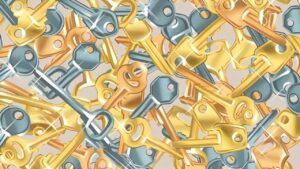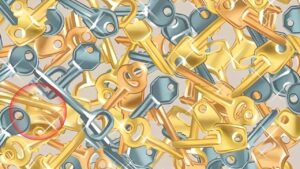Have you ever wondered why certain visual challenges can stump even the brightest minds? The latest optical illusionsweeping across social media platforms presents a deceptively simple task: locate a single bell hidden among dozens of keys within five seconds. This seemingly straightforward puzzle has sparked widespread fascination and frustration in equal measure.
What makes this particular optical illusion so captivating isn’t just its difficulty—it’s the profound insights it offers into how our brains process visual information. Unlike typical puzzles that rely on logic or mathematical reasoning, this challenge taps directly into our most fundamental cognitive processes, revealing the intricate workings of human perception.

The phenomenon has captured attention from neuroscientists, educators, and puzzle enthusiasts alike. Research institutions have begun studying similar visual challenges to better understand cognitive processing speed and its relationship to overall brain health. Meanwhile, millions of people continue sharing their attempts on social platforms, creating a global community united by this shared visual challenge.
The Science Behind Visual Perception and Optical Illusions
How Your Brain Processes Complex Visual Information
When you encounter this optical illusion, your visual system launches into an incredibly sophisticated sequence of operations. The retina captures the image, transmitting signals through the optic nerve to the visual cortex, where specialized neurons begin analyzing shapes, patterns, and spatial relationships simultaneously.
Your brain doesn’t simply “see” the image as a camera might record it. Instead, it actively constructs your visual experience through rapid-fire predictions and pattern matching. This process explains why the bell becomes so effectively camouflaged among the keys—your visual system, optimized for efficiency, begins recognizing the dominant pattern (keys) and struggles to identify the anomaly (bell).
The challenge becomes even more complex when time pressure is introduced. Under the five-second constraint, your cognitive resources must balance speed with accuracy, often leading to the overlooking of subtle differences that would be obvious during leisurely examination.
Why Pattern Recognition Fails in This Optical Illusion
The genius of this optical illusion lies in its exploitation of our pattern recognition shortcuts. Evolution has equipped human vision with remarkable efficiency in identifying familiar objects, but this same efficiency can become a liability when searching for subtle variations within similar-looking items.
Keys and bells share certain visual characteristics—metallic surfaces, similar sizes, and comparable shapes—that trigger overlapping neural responses. Your brain’s pattern recognition system, designed to quickly categorize objects for survival purposes, can inadvertently group the bell with the surrounding keys, effectively rendering it invisible despite being in plain sight.
This phenomenon, known as “attentional blindness,” demonstrates how our cognitive systems prioritize rapid categorization over detailed analysis. While this serves us well in most daily situations, it creates the perfect conditions for this type of visual puzzle to challenge even the most observant individuals.
Cognitive Benefits of Engaging with Visual Puzzles
Strengthening Neural Pathways Through Practice
Regular engagement with optical illusion challenges like the hidden bell puzzle offers measurable cognitive benefits. Neuroscientific research has documented how visual search tasks activate multiple brain regions simultaneously, creating what researchers call “cross-training” for your cognitive abilities.
Each attempt to solve the puzzle strengthens neural pathways responsible for visual attention, pattern recognition, and processing speed. These improvements extend beyond puzzle-solving, potentially enhancing performance in real-world tasks requiring visual acuity and attention to detail.
Studies tracking individuals who regularly practice visual challenges show improvements in concentration span, reduced susceptibility to visual distractions, and enhanced ability to notice important details in complex environments. These benefits accumulate over time, suggesting that puzzle engagement could serve as a form of cognitive maintenance.
Professional Applications of Visual Search Skills
The skills tested by this optical illusion have significant real-world applications across numerous professional fields. Airport security personnel, medical imaging specialists, quality control inspectors, and air traffic controllers all rely on the same visual processing abilities challenged by the hidden bell puzzle.
Research conducted by government agencies has demonstrated strong correlations between performance on visual search tasks and effectiveness in security screening operations. Individuals who excel at spotting hidden objects in puzzles tend to show superior performance in detecting prohibited items in X-ray imagery.
Medical professionals also benefit from enhanced visual search capabilities. Radiologists, pathologists, and emergency room physicians must quickly identify anomalies within complex visual information—skills directly comparable to those required for solving optical illusion puzzles.
Strategies for Mastering the Hidden Bell Challenge
Systematic Scanning Techniques
Success with this optical illusion requires moving beyond random visual searching toward methodical examination strategies. Professional visual searchers employ grid-based scanning techniques that divide complex images into manageable sections, ensuring comprehensive coverage without redundant effort.
Begin by mentally dividing the image into four quadrants, then systematically examine each section from left to right, top to bottom. This structured approach prevents the common error of repeatedly scanning the same areas while missing others entirely.
Advanced practitioners develop what researchers call “search schemas”—mental templates that guide attention toward areas most likely to contain hidden objects. For the bell puzzle, focus particularly on edges and corners where camouflage effects tend to be strongest.
Understanding Visual Camouflage Principles
The effectiveness of this optical illusion depends on strategic placement principles that maximize the bell’s concealment among the keys. Understanding these principles can significantly improve your detection success rate.
Objects become camouflaged through three primary mechanisms: shape similarity, orientation matching, and spatial clustering. The hidden bell likely shares similar proportions to surrounding keys, adopts comparable orientation, and sits within dense groupings that mask its distinctive features.
Successful searchers learn to look beyond obvious differences, instead focusing on subtle variations in curvature, shadow patterns, or surface textures that distinguish the bell from surrounding keys. This requires training your attention to notice second-order visual features rather than relying solely on obvious shape differences.
Performance Metrics and Improvement Tracking
Benchmarking Your Visual Search Abilities
Performance on this optical illusion varies significantly across different populations, with success rates and completion times serving as useful benchmarks for cognitive assessment. Beginning puzzlers typically require 45-60 seconds to locate the hidden bell, with success rates around 65 percent.
Intermediate practitioners generally solve the challenge within 20-30 seconds, achieving success rates near 80 percent. Advanced individuals consistently complete the task in 10-15 seconds with 95 percent accuracy, while expert-level performers can locate the bell within 5-10 seconds with near-perfect reliability.
These performance metrics provide valuable feedback for tracking cognitive improvement over time. Regular practitioners often see measurable gains within weeks of consistent practice, with the most significant improvements occurring during the initial learning phase.
Training Programs for Visual Enhancement
Structured training protocols can accelerate improvement in optical illusion solving abilities. Effective programs combine systematic practice with strategic instruction, focusing on both technical scanning methods and cognitive awareness development.
Progressive difficulty training starts with simpler visual search tasks before advancing to complex challenges like the hidden bell puzzle. This scaffolded approach allows practitioners to develop foundational skills while building confidence through achievable milestones.
Advanced training incorporates time pressure gradually, helping practitioners maintain accuracy while increasing processing speed. This approach mirrors professional training protocols used in high-stakes visual search occupations, where both speed and accuracy are essential for effective performance.
The Cultural Impact of Viral Visual Challenges
The hidden bell optical illusion represents part of a broader cultural phenomenon where visual puzzles unite global audiences through shared cognitive challenges. Social media platforms have transformed these traditional puzzles into viral content that transcends linguistic and cultural barriers.
This democratization of cognitive testing has created unprecedented opportunities for large-scale research into human visual processing. Millions of attempts provide researchers with vast datasets for understanding how different populations approach and solve visual challenges.
The social aspect of puzzle sharing has also created supportive communities where individuals celebrate cognitive achievements and share solution strategies. This collaborative environment encourages continued engagement and learning, extending the benefits beyond individual cognitive improvement to collective knowledge building.

Frequently Asked Questions
Q: How long should it take to find the hidden bell? A: Most people solve this puzzle within 15-45 seconds, though timing varies based on experience and individual visual processing speed. Don’t worry if it takes longer initially—improvement comes with practice.
Q: Does success on this optical illusion indicate higher intelligence? A: While these puzzles test specific cognitive abilities like visual attention and pattern recognition, they represent only one aspect of intelligence. Success indicates good visual processing skills rather than overall intellectual capacity.
Q: Can practicing these puzzles improve my cognitive abilities? A: Yes, research shows that regular practice with visual search tasks can enhance attention span, pattern recognition speed, and concentration abilities. These improvements often transfer to real-world visual tasks.
Q: Why do some people find this optical illusion easier than others? A: Individual differences in visual processing speed, attention control, and prior experience with similar puzzles all influence performance. Age, visual acuity, and cognitive training background also play important roles.
Q: Are there any tricks to solving visual puzzles faster? A: Systematic scanning techniques, understanding camouflage principles, and regular practice are the most effective approaches. Avoid random searching and instead develop methodical examination strategies.
